While Maine’s brutal winters can kill tender garden favorites, you’ll discover that native plants actually flourish in these challenging conditions. These hardy survivors don’t just endure temperatures that plummet to -20°F, they’ve evolved over thousands of years to celebrate Maine’s unique climate patterns. You can transform your landscape with species that require minimal maintenance, support local wildlife, and showcase stunning colors that rival any exotic import. The secret lies in understanding which natives match your specific growing conditions.
Contents
Maine’s Harsh Winter Climate Challenges
While Maine’s winters have traditionally been known for their brutal cold, the state’s winter climate has been changing dramatically over the past century. You’re now facing temperatures that have risen almost 3.5°F since 1900, with winter warming occurring twice as fast as summer warming since the mid-1990s.
This creates unique challenges for climate resilience gardening. Your plants must handle unpredictable conditions, from extreme lows of 7.9°F to fluctuating highs reaching 24.4°F. You’ll need native species with proven winter survival strategies that can adapt to Maine’s increasingly erratic weather patterns while still thriving. The growing season has lengthened due to these winter warming effects, providing both opportunities and complications for plant selection.
Colorful Wildflowers for Maine Gardens
Maine’s native wildflowers offer stunning seasonal color while supporting local ecosystems. From spring’s early bloomers to summer’s vibrant displays, these hardy perennials thrive in Maine’s unique growing conditions. These plants self-seed regularly, creating natural colonies that return year after year with minimal maintenance.
Wild Lupine (Lupinus Perennis)

Wild Lupine is a stunning herbaceous perennial that produces striking blue to purple flower spikes in late spring to early summer. This native wildflower reaches up to 2 feet tall and features distinctive palm-shaped leaves that create an attractive backdrop for its showy blooms. Though extirpated from Maine, Wild Lupine can be successfully reintroduced to gardens and restoration sites.
Beyond its ornamental value, Wild Lupine serves as the exclusive host plant for the endangered Karner blue butterfly and supports numerous native pollinators including mining and mason bees. Its adaptability to sandy, well-drained soils makes it an excellent choice for challenging garden sites while contributing to regional biodiversity and conservation efforts. When growing Wild Lupine, avoid the non-native big leaf lupine, which is considered potentially invasive and can cause environmental damage to natural communities.
- Hardiness: USDA zones 3-9
- Light: Full sun to part shade
- Water: Low to moderate; drought tolerant once established
- Soil: Sandy, well-drained soils; tolerates poor, acidic to neutral pH
- Fertilizer: None required; fixes nitrogen naturally as a legume
- Pest/Disease Resistance: Generally resistant; may experience aphids occasionally
- Growth Rate: Moderate; takes 2-3 years to establish from seed
New England Aster (Symphyotrichum)

New England Aster is a striking native wildflower that brings vibrant color to Maine gardens from late summer through fall. Growing 3-6 feet tall with a 2-3 foot spread, this clump-forming perennial produces masses of daisy-like flowers in shades of blue, purple, pink, and white with bright yellow centers. Each flower head contains 45-100 ray petals, creating an impressive display.
This exceptional pollinator plant serves as a critical late-season nectar source for migrating monarch butterflies and numerous native bee species. New England Aster also functions as a larval host for Pearl Crescent and checkerspot butterflies, making it invaluable for supporting local biodiversity and strengthening pollinator habitat in Maine landscapes. As a popular horticultural choice, this species may occasionally escape from cultivation and establish in nearby natural areas.
- Hardiness: USDA Zone 4, suitable for Maine winters
- Light: Full sun to part shade, flowers best in abundant sunlight
- Water: Moist but well-drained conditions; avoid waterlogged soils
- Soil: Tolerates acidic pH below 6.8; thrives in various soil types with good drainage
- Fertilizer: Low maintenance; typically requires no supplemental fertilization
- Pest/Disease Resistance: Generally resistant to major pests and diseases
- Growth Rate: Moderate to fast; can become aggressive in ideal moist conditions
Black-Eyed Susan (Rudbeckia)
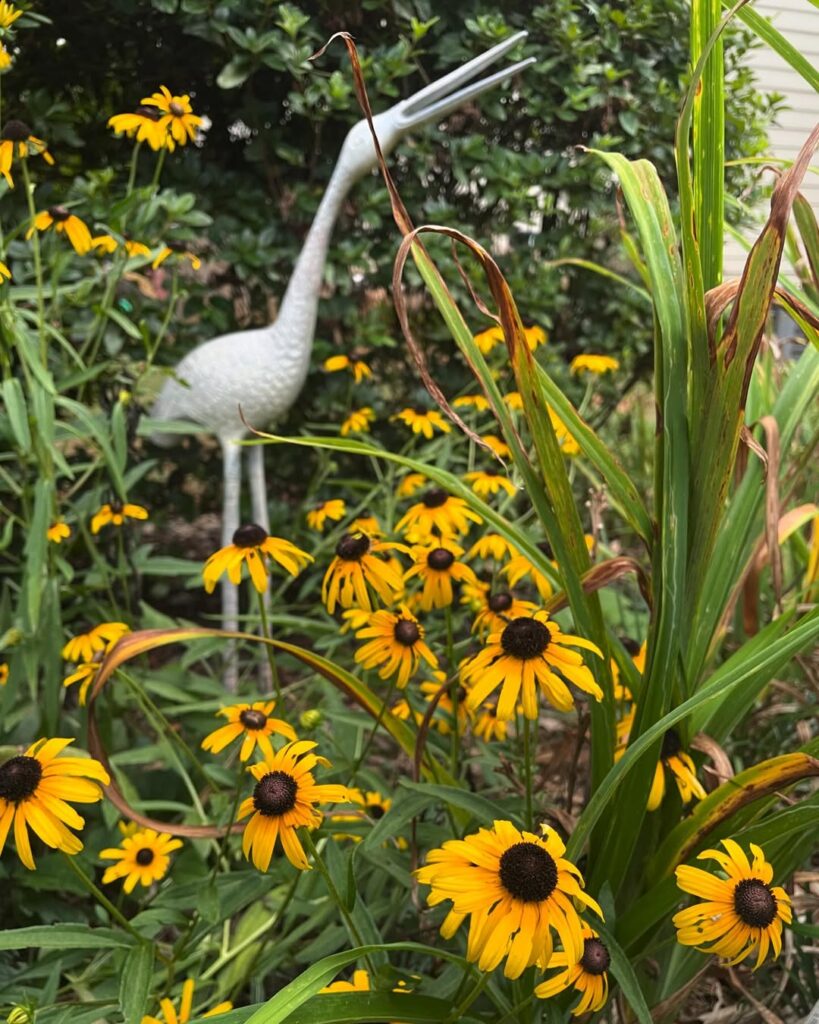
Black-Eyed Susan (Rudbeckia hirta) is a quintessential Maine wildflower that brings vibrant golden-yellow blooms with distinctive dark centers to gardens from midsummer through early fall. Growing up to 3 feet tall, this adaptable native produces 2-3 inch daisy-like flowers that last up to a month each, creating long-lasting color in the landscape.
This hardy wildflower thrives throughout New England’s diverse habitats, from meadows and prairies to roadsides and open woodlands. Black-Eyed Susan serves as an ecological powerhouse, attracting native pollinators, supporting Checkerspot butterfly larvae, and providing seeds for goldfinches and other birds while helping control erosion and fix nitrogen in the soil. The plant features a distinctive basal rosette growth pattern in its first year before developing into a tall flowering clump.
- Hardiness: USDA zones 3-9, extremely cold tolerant
- Light: Full sun preferred, tolerates light shade
- Water: Drought tolerant once established, minimal watering needed
- Soil: Well-drained soils, tolerates sandy, loamy, or clay; pH 6.0-7.5
- Fertilizer: None required, naturally fixes nitrogen
- Pest/Disease Resistance: Deer resistant, generally pest and disease free
- Growth Rate: Moderate to fast, readily self-seeds
Wild Bergamot (Monarda Fistulosa)

Wild Bergamot (Monarda fistulosa) is a native Maine perennial that forms dense clumps 2-4 feet tall. This aromatic wildflower produces pale lavender to purple tubular flowers in summer whorls, attracting bees, butterflies, and hummingbirds. Its toothed, opposite leaves release a distinctive fragrance when crushed.
Historically used by Native Americans for medicinal purposes, Wild Bergamot’s leaves can flavor teas and seasonings. This drought-tolerant species thrives in prairies, rocky woods, and roadsides, spreading by underground runners. The plant commonly establishes in anthropogenic habitats including fields, roadsides, forests, and clearings where it adapts to various environmental conditions. Unlike other bee balms, it shows excellent resistance to powdery mildew while maintaining deer resistance.
- Hardiness: USDA Zone 4
- Light: Full sun
- Water: Drought tolerant; prefers well-drained conditions
- Soil: Well-drained soils; tolerates dry, rocky conditions
- Fertilizer: Low maintenance; no special fertilizer requirements
- Pest/Disease Resistance: Deer resistant; excellent powdery mildew resistance; may be susceptible to rust in poor conditions
- Growth Rate: Moderate; spreads by underground runners
Cardinal Flower (Lobelia Cardinalis)

Cardinal Flower (Lobelia cardinalis) is a stunning native perennial wildflower that brings brilliant scarlet-red color to Maine gardens. This member of the Bluebell family produces dramatic terminal flower spikes resembling flaming red spires, growing 1-6 feet tall with lance-shaped leaves along the stem. The tubular flowers bloom from midsummer through late summer and are specially adapted for hummingbird pollination.
This remarkable wildflower thrives in wetland conditions and can even survive completely submerged underwater with adequate light. Cardinal Flower makes an excellent choice for water gardens, pond edges, and consistently moist areas where its striking red blooms create a bold focal point against green foliage. Though classified as a short-lived perennial, this plant reseeds readily, ensuring continued presence in the garden for years to come.
- Hardiness: Native perennial suited to Maine climate zones
- Light: Full sun to partial shade, prefers filtered light
- Water: Requires consistently moist to wet soil conditions, can grow in shallow water
- Soil: Adaptable to various soil types as long as moisture requirements are met
- Fertilizer: Low maintenance, no special fertilizer requirements needed
- Pest/Disease Resistance: Rarely browsed by herbivores, generally pest-resistant
- Growth Rate: Moderate growth rate, reaching mature height of 1-6 feet
Maine’s Cold-Hardy Native Trees
Maine’s cold-hardy native trees have adapted to harsh winters and brief growing seasons, thriving as both conifers and deciduous species across the state’s diverse ecosystems. These trees provide essential food and habitat for local wildlife, supporting chipmunks, deer mice, songbirds, and various other species through their seeds, fruits, and shelter.
Eastern White Pine (Pinus)
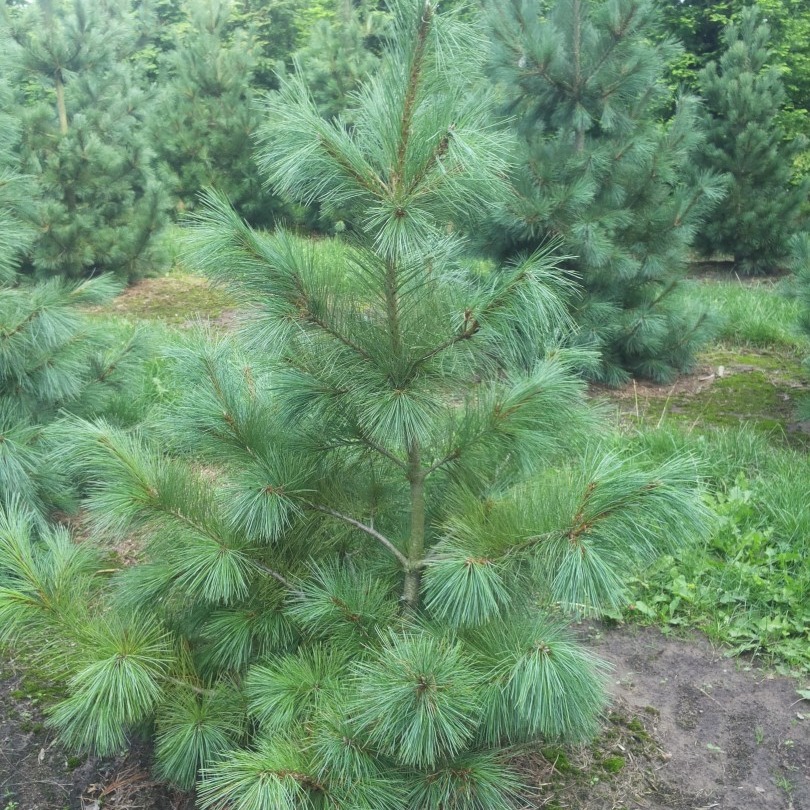
The Eastern White Pine stands as Maine’s official state tree, exemplifying the rugged beauty and practicality that defines the region’s native flora. This magnificent evergreen is easily recognized by its soft, bluish-green needles arranged in distinctive bundles of five, reaching up to 5 inches long with a characteristic feathery texture.
Renowned for its rapid growth and impressive stature, Eastern White Pine can reach 50-80 feet in cultivation and over 100 feet in natural settings. Its versatility makes it invaluable for Maine landscapes, serving effectively as windbreaks, specimen trees, or even pruned hedges. The species produces attractive cylindrical brown cones and offers exceptional ecological value while providing soft, workable timber historically essential to the region’s economy. These trees provide prime nesting habitat for various bird species and support local wildlife populations throughout the year.
- Hardiness: Zones 3-8, extremely cold-hardy for Maine’s harsh winters
- Light: Full sun to partial shade, adaptable to various light conditions
- Water: Tolerates wide range from dry to wet soil conditions
- Soil: Adaptable to diverse soil types, well-draining preferred
- Fertilizer: Generally not required, thrives in native soils
- Pest/Disease Resistance: Generally hardy with good natural resistance
- Growth Rate: Fast-growing, rapid establishment compared to other conifers
Sugar Maple (Acer Saccharum)
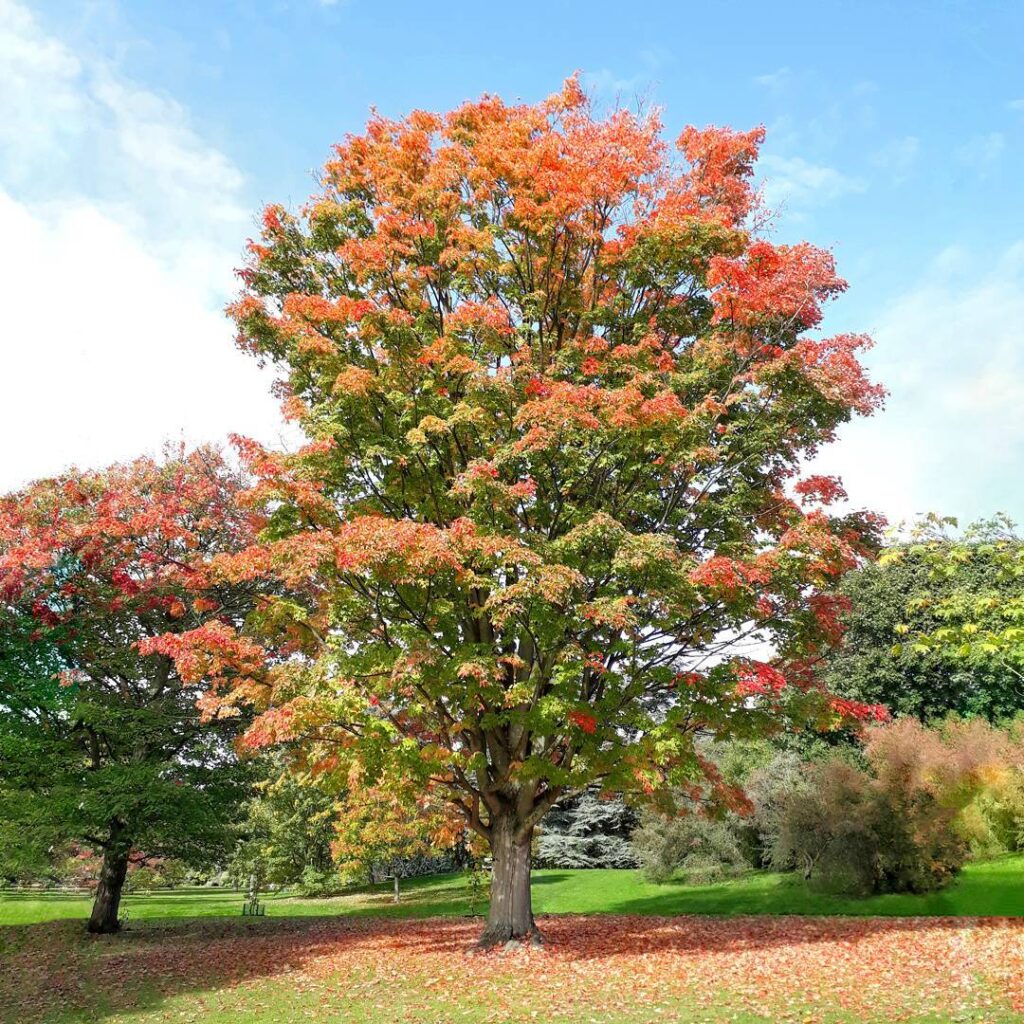
The Sugar Maple is Maine’s quintessential native tree, reaching heights of 50-130 feet with magnificent fall foliage in brilliant yellows, oranges, and reds. This cold-hardy species thrives in northern hardwood forests and serves as the premier source for maple syrup production throughout New England.
Beyond its economic value, the Sugar Maple excels as a shade tree with dense, oval growth habit and exceptional longevity. Its ecological importance cannot be overstated, providing habitat for wildlife while contributing organic matter that enriches forest soils and supports diverse woodland ecosystems. Many specimens planted by colonial settlers still survive today, displaying the impressive large trunks and deeply fissured bark characteristic of mature trees.
- Hardiness: USDA Zone 3 and colder, exceptionally tolerant of harsh Maine winters
- Light: Shade-tolerant, thrives in partial shade to full sun conditions
- Water: Prefers consistent moisture; requires supplemental watering in dry conditions
- Soil: Moist, well-drained soils; performs poorly on dry, shallow, or compacted sites
- Fertilizer: Low maintenance; typically does not require supplemental feeding
- Pest/Disease Resistance: Generally resistant but vulnerable in poor urban environments
- Growth Rate: Vigorous seedling development; long-lived with lifespans exceeding 100 years
Paper Birch (Betula Papyrifera)
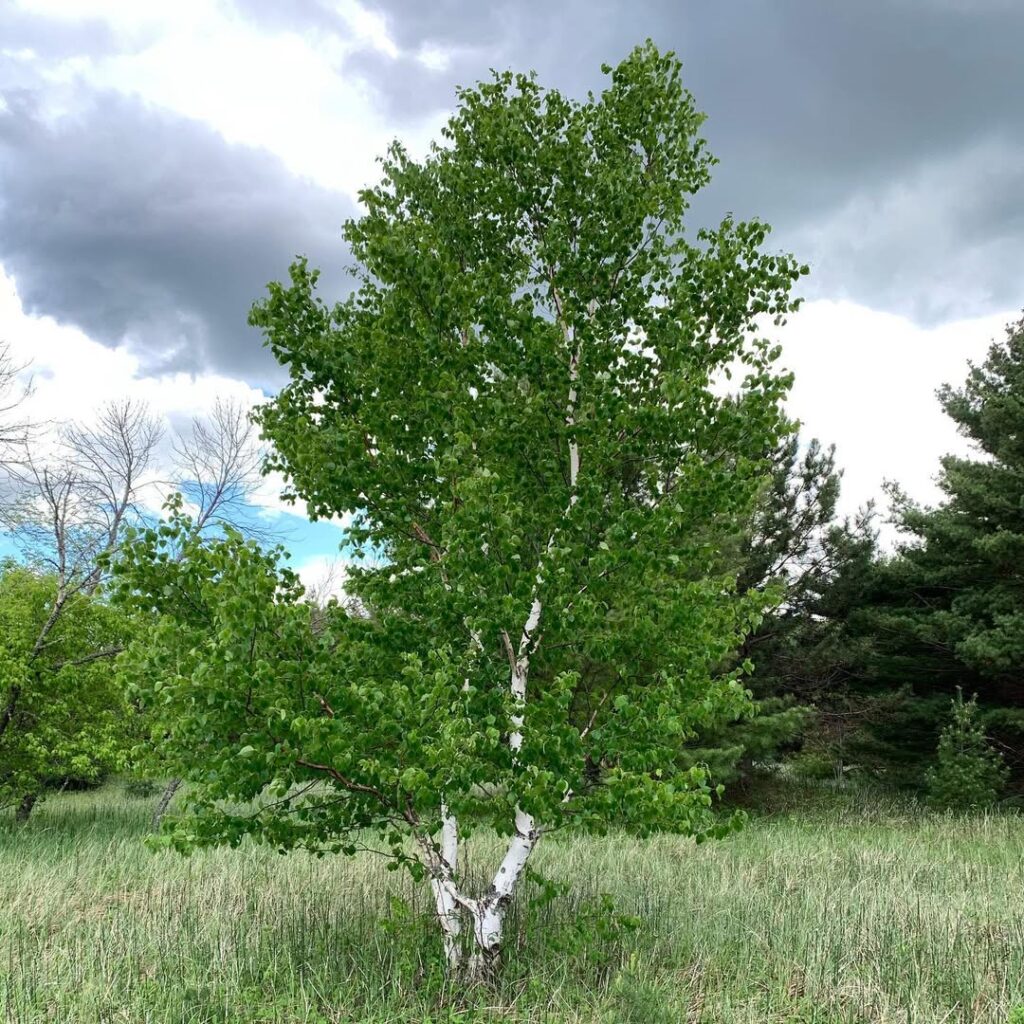
Paper Birch (Betula papyrifera) stands as one of Maine’s most iconic native trees, earning the title “king of the northern birches” for its exceptional ornamental value. This medium-sized tree reaches 60-80 feet tall and is instantly recognizable by its distinctive white, papery bark that peels in layers on mature specimens. The bark shifts from reddish-brown on young saplings to brilliant white as the tree matures.
Beyond its striking winter appeal, Paper Birch offers year-round interest with spring catkins, serrated oval leaves, brilliant golden fall foliage, and cone-like fruits. The tree serves as an important food source for wildlife including beavers and snowshoe hares. Historically significant to indigenous peoples for canoe construction, this fast-growing native thrives in Maine’s diverse landscapes from mixed forests to mountain slopes, making it an excellent choice for naturalistic plantings and accent use.
- Hardiness: Zones 1-5, extremely cold-hardy throughout Maine and northern regions
- Light: Full sun to partial shade, adaptable to various light conditions
- Water: Requires adequate moisture, prefers consistently moist but well-drained conditions
- Soil: Rich, moist, well-drained sandy loam preferred but adaptable to various soil types
- Fertilizer: Generally low maintenance, benefits from organic matter in poor soils
- Pest/Disease Resistance: Moderate resistance, may be susceptible to bronze birch borer in stressed conditions
- Growth Rate: Fast-growing when provided with adequate moisture and suitable conditions
American Beech (Fagus Grandifolia)
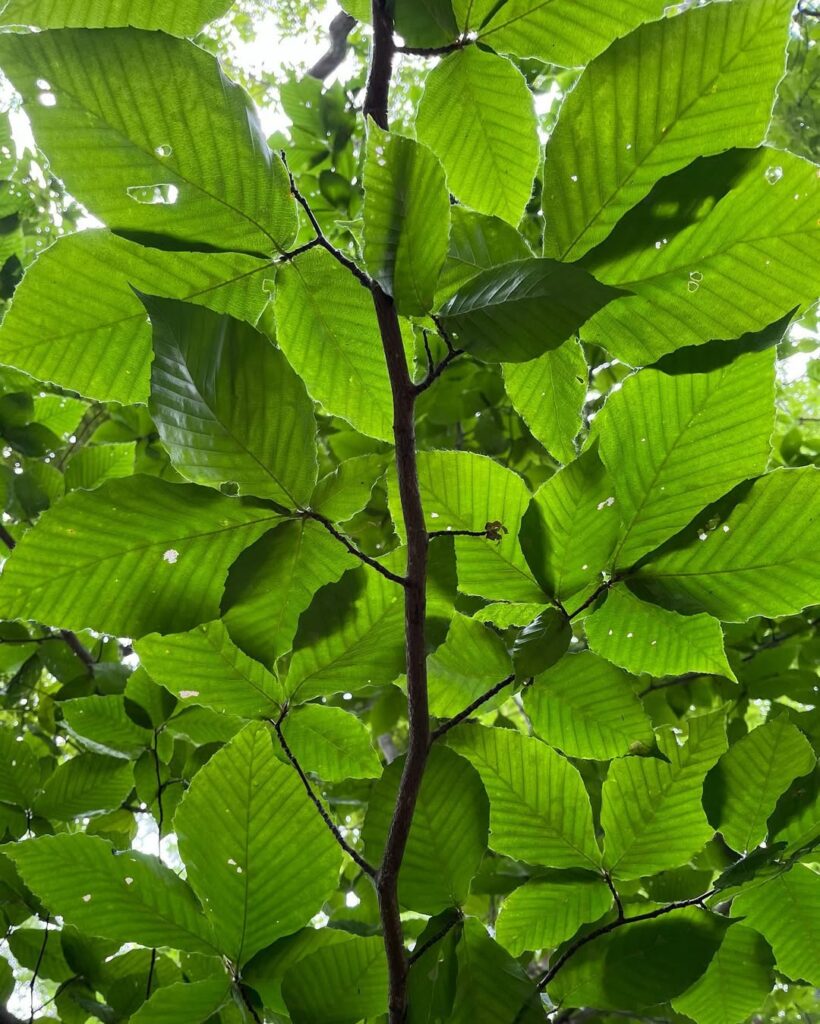
American Beech (Fagus grandifolia) is a magnificent native tree distinguished by its exceptionally smooth, light gray bark and wide-spreading crown. This slow-growing deciduous species can live up to 300 years, reaching heights of 50-70 feet with a canopy spread of 25-50 feet. The simple, toothed leaves turn golden-brown in fall and persist late into winter.
Beyond its ornamental value, American Beech serves as a cornerstone species in Maine’s forest ecosystems. The tree produces beechnuts that provide essential wildlife food, while its bark supports various lichens and organisms. The species also propagates through beech suckers, creating clusters of genetically identical saplings around mature parent trees. Its resistance to deer browsing and slight salt tolerance make it excellent for both natural settings and roadside plantings.
- Hardiness: USDA zones 4-9
- Light: Full sun to partial shade
- Water: Moderate moisture, drought tolerant once established
- Soil: Well-drained soils, reaches greatest size in alluvial soils
- Fertilizer: Minimal requirements, thrives in natural forest conditions
- Pest/Disease Resistance: Generally resistant, bark supports beneficial lichens
- Growth Rate: Slow-growing
Northern Red Oak (Quercus)

The Northern Red Oak is Maine’s most common oak species, thriving statewide with particular abundance in southern regions. This large deciduous tree reaches 60-80 feet tall and serves as a cornerstone of Maine’s forest ecosystems. Notable for its distinctive dark green leaves with bristle-tipped lobes that transform into vibrant red fall color, it provides essential wildlife habitat and food through its acorn production.
Extremely cold-hardy and adaptable, Northern Red Oak tolerates Maine’s harsh winters while supporting diverse wildlife including turkeys, deer, bears, and squirrels. Its moderate to fast growth rate, combined with exceptional longevity of up to 400 years, makes it valuable for both natural forests and landscape plantings. The species demonstrates remarkable resilience to urban stresses, salt, and air pollution. Mammals like raccoons commonly use hollows in mature trunks for protective dens and shelter.
- Hardiness: USDA zones 3-7, extremely cold-hardy for Maine winters
- Light: Full sun to partial shade; ideal growth in open environments
- Water: Prefers moist, well-drained soil; tolerates dry and exposed sites
- Soil: Adaptable to various types including clay and alkaline; prefers slightly acidic, rich upland soils
- Fertilizer: Low maintenance; benefits from soil fertility contributions to forest ecosystem
- Pest/Disease Resistance: Generally resistant; acorn production may be affected by late spring frosts
- Growth Rate: Moderate to fast; 10-year-old trees reach 16-20 feet under ideal conditions
Maine’s Best Native Shrubs
Maine’s diverse native shrubs offer exceptional landscape value, from groundcover blueberries to towering serviceberries, providing wildlife habitat, seasonal beauty, and low-maintenance gardening solutions across various growing conditions. These native species attract pollinators and beneficial insects, creating vibrant ecosystems that support local biodiversity.
Lowbush Blueberry (Vaccinium Angustifolium)
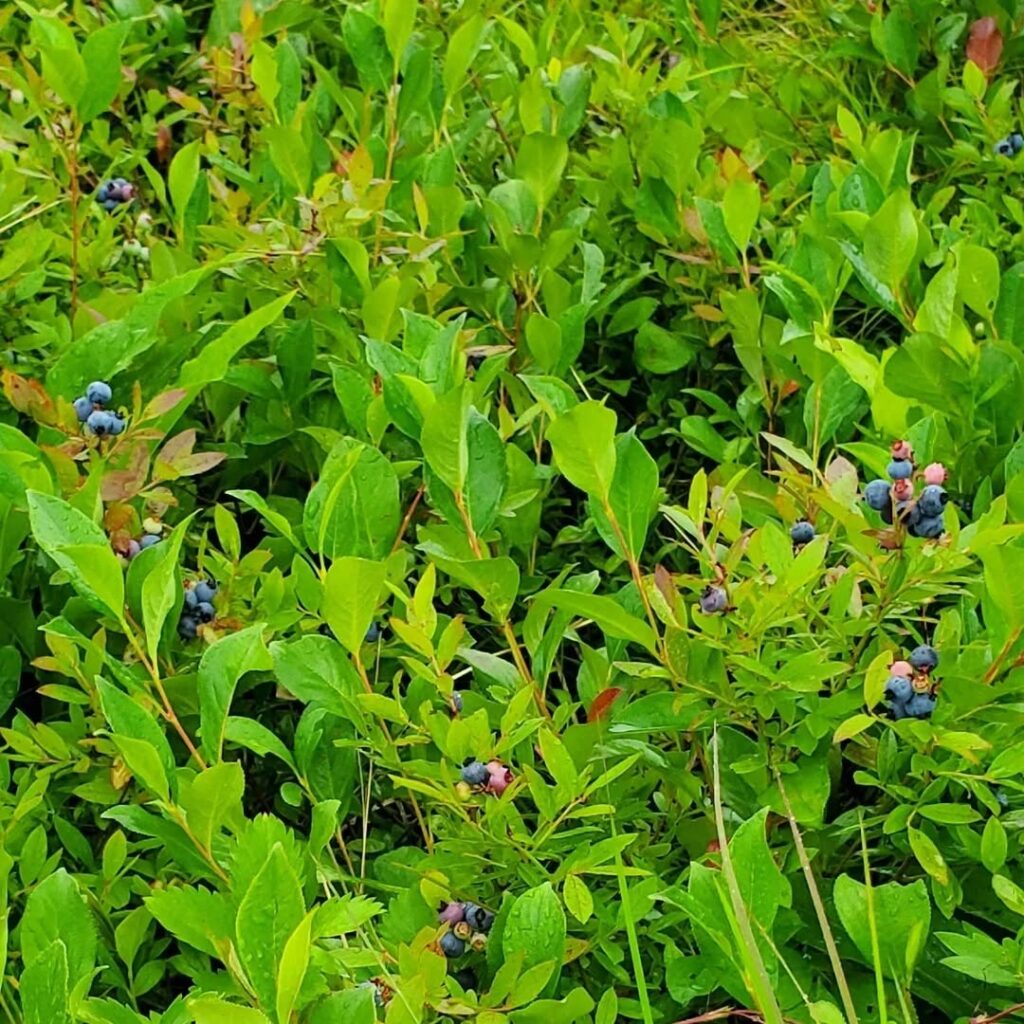
The Lowbush Blueberry is Maine’s iconic native shrub, forming a low-spreading deciduous plant that reaches just 5-60 cm tall. This hardy species produces delicate white or pink bell-shaped flowers followed by powder blue to black berries rich in antioxidants and vitamin C. Its glossy blue-green summer foliage transforms to brilliant reds in fall.
This fire-tolerant shrub thrives in Maine’s challenging conditions where highbush varieties cannot survive. Its rhizomatous growth habit allows it to colonize disturbed sites and lie dormant for decades. The berries ripen in mid-August, providing essential food for wildlife while serving as North America’s leading commercial wild blueberry source.
The species adapts well to extreme environments, flourishing in alpine zones, mountain summits, and exposed ridges throughout the region.
- Hardiness: Extremely cold hardy, thrives in areas where highbush blueberries cannot survive
- Light: Partial to full sun exposure
- Water: Moderate water needs, prefers well-drained conditions
- Soil: Acidic, well-drained soil; tolerates challenging soils including mine tailings
- Fertilizer: Low fertilizer requirements due to adaptation to nutrient-poor soils
- Pest/Disease Resistance: Good natural resistance, fire-tolerant
- Growth Rate: Moderate to slow, spreads via rhizomes over time
Winterberry Holly (Ilex Verticillata)
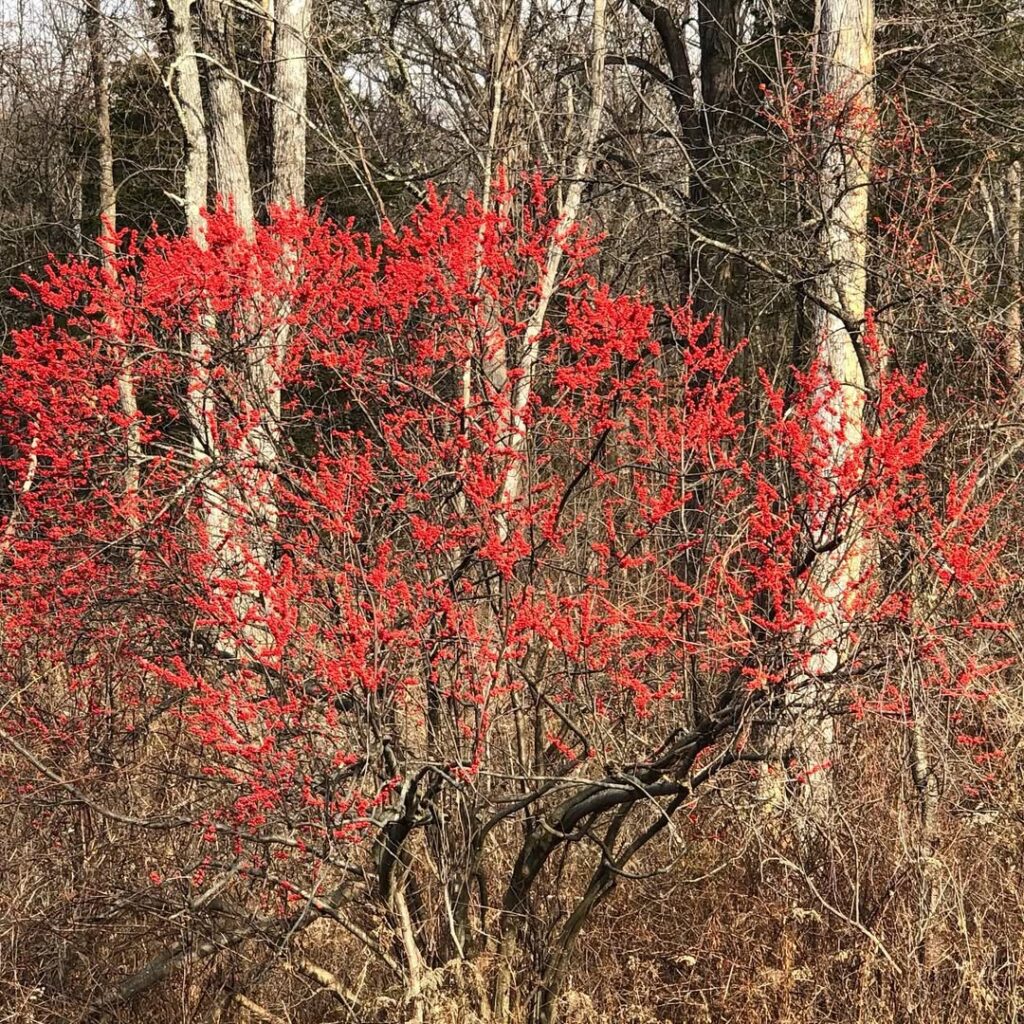
Winterberry Holly is a deciduous native shrub that grows 3-15 feet tall and wide, producing spectacular bright red berries that persist through winter after the leaves drop. This Maine native requires both male and female plants for berry production, with one male pollinating up to six females within 50 feet. The shrub forms dense thickets and offers excellent ornamental value with deep green summer foliage that turns yellow in fall.
Beyond its striking appearance, Winterberry Holly provides essential ecological benefits as a native species. The abundant red berries serve as crucial winter food for birds during harsh Maine winters, while the dense growth offers nesting habitat and cover for wildlife. Non-native invasive plants continue to threaten Maine’s natural ecosystems, making the choice to plant native species like Winterberry Holly increasingly important for biodiversity conservation. This adaptable shrub thrives in various conditions from wetlands to dry sites, making it an excellent choice for Maine landscapes seeking both beauty and ecological function.
- Hardiness: Hardy in Maine (USDA zones 3-9)
- Light: Partial shade to full sun (better fruiting in higher light)
- Water: Tolerates spring flooding and summer drought once established; adaptable to variable moisture
- Soil: Adaptable to various soil types, from wet areas to dry sand dunes
- Fertilizer: Minimal fertilizer needs once established
- Pest/Disease Resistance: Excellent resistance with minimal pest and disease issues
- Growth Rate: Moderate growth rate, forms dense thickets over time
Serviceberry (Amelanchier Canadensis)
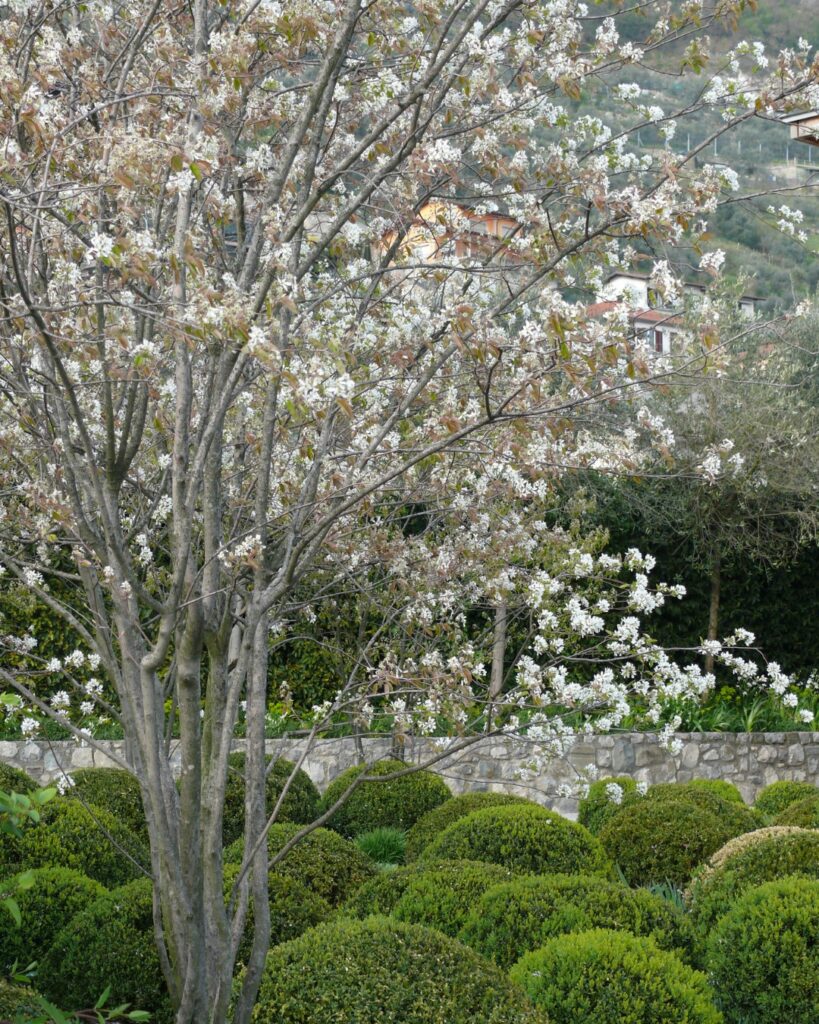
Serviceberry (Amelanchier canadensis) is a versatile native shrub that serves as one of Maine’s most valuable landscape plants. This multi-stemmed deciduous shrub typically grows 6-20 feet tall, featuring smooth gray bark and producing spectacular white flower clusters in early spring before most other natives bloom. The plant offers year-round interest with its showy spring flowers, sweet purple-black berries in summer, and vibrant reddish-orange fall foliage.
Beyond its ornamental value, serviceberry provides exceptional ecological benefits. The early spring blooms attract native pollinators, while the edible fruits feed numerous bird and mammal species. As a larval host plant for butterflies and moths, it supports local biodiversity. The berries are also prized by humans for jams, pies, and fresh eating, earning it alternative names like juneberry and shadbush. By choosing native plants like serviceberry, Maine gardeners help create vegetation corridors that support wildlife movement and biodiversity conservation.
- Hardiness: USDA Zones 4-9, well-suited for Maine’s climate extremes
- Light: Full sun to partial shade
- Water: Prefers moist, well-drained sites but shows moderate drought tolerance
- Soil: Tolerates wide range including sandy loams and coarse loamy sands; adapts to both wetland and non-wetland environments
- Fertilizer: Low maintenance; benefits from mycorrhizal associations for enhanced nutrient acquisition
- Pest/Disease Resistance: Good overall resistance with few serious issues
- Growth Rate: Moderate; early-successional species capable of colonizing disturbed areas
Red-Osier Dogwood (Cornus Sericea)

Red-Osier Dogwood is a stunning native shrub that reaches 6-12 feet tall with an upright, rounded form. Its most striking feature is the bright red stems that provide winter interest, contrasting beautifully with dark green summer foliage. The shrub produces clusters of white flowers followed by whitish fruits that persist into winter, making it valuable for wildlife. Also known as Red-twig Dogwood, this adaptable plant forms natural thickets and serves as an excellent choice for naturalized landscapes and riparian areas.
This versatile shrub thrives in Maine’s wetland environments and along waterways, where it provides essential habitat for wildlife while stabilizing soil with its spreading root system. The plant is particularly valuable for streambank stabilization and wetland restoration projects due to its dense root structure.
- Hardiness: Zones 2-7, extremely cold hardy throughout Maine
- Light: Full sun to partial shade, tolerates various light conditions
- Water: Prefers consistently moist to wet conditions, excellent for wet sites
- Soil: Moist, somewhat poorly drained, moderately acidic to neutral soils
- Fertilizer: Low maintenance, rarely needs supplemental fertilization
- Pest/Disease Resistance: Generally resistant with few serious issues
- Growth Rate: Moderate to fast, spreads by underground stems and rooting branches
Speckled Alder (Alnus Incana)

Speckled Alder (Alnus incana ssp. rugosa) is a multi-stemmed native shrub belonging to the birch family, distinguished by its characteristic speckled bark. This versatile plant thrives throughout Maine’s varied landscapes, from stream banks and lake shores to damp meadows and wetland edges.
Beyond its ornamental value, Speckled Alder provides exceptional ecological benefits through nitrogen-fixing root nodules that enrich soil fertility. The shrub excels at erosion control along waterways while creating valuable wildlife habitat and natural screening in landscape applications. This species notably increases timber yields of nearby ash, tupelo, and poplar trees by sharing its fixed nitrogen with surrounding forest species.
- Hardiness: Zones 2-7, well-adapted to Maine’s climate
- Light: Full sun to partial shade, performs best in sunny locations
- Water: High moisture requirements, tolerates flooding and occasional drought
- Soil: Adaptable to sandy, gravelly, loamy, clayey, and mucky soils
- Fertilizer: Minimal requirements due to nitrogen-fixing capabilities
- Pest/Disease Resistance: Generally resistant with few serious issues
- Growth Rate: Moderate to fast, especially in ideal wet conditions
Selecting the Right Native Plants for Your Garden
How do you choose the perfect native plants when Maine offers such an incredible variety for every garden situation? Start by evaluating your specific growing conditions, including sunlight exposure, moisture levels, and existing soil quality.
For sunny, drought-prone areas with poor soils, Creeping Juniper thrives without extensive soil preparation. Shady spots with good organic matter suit Foam Flower perfectly. Moist, partly sunny locations work well for Beebalm, though you’ll need proper planting techniques to contain its aggressive spread.
Consider your maintenance preferences too. Native plants require less upkeep than traditional landscaping, but aggressive spreaders need defined spaces. Native plants are adapted to local soil and climate conditions, making them naturally more resilient in Maine’s varying environmental conditions.
Frequently Asked Questions
Where Can I Buy Native Maine Plants Locally?
You’ll find native plant sales at local nurseries like 5 Star Nursery in Brooklin, Crystal Lake Farm in Washington, and Blue Aster in South China. Conservation districts and Maine Audubon also offer native plants locally.
When Is the Best Time to Plant Native Species in Maine?
Coincidentally, you’re asking right when Maine’s ideal planting season begins! Fall planting from early September through Indigenous Peoples Day beats spring planting—you’ll get better root establishment and less maintenance next year.
How Do I Prepare Soil for Maine Native Plants?
Start with soil testing to determine pH and nutrient levels. You’ll typically need fewer organic amendments since native plants tolerate poor soils better than introduced species. Focus on proper drainage and weed control instead.
Do Maine Native Plants Attract Wildlife Like Birds and Butterflies?
You’ll be amazed by what happens when you plant native species—suddenly your yard becomes a wildlife magnet. Maine natives create incredible pollinator gardens and deliver exceptional wildlife benefits, attracting countless birds, butterflies, and beneficial insects year-round.
How Much Maintenance Do Native Maine Plants Require Annually?
Native Maine plants need minimal annual upkeep once established after 2-3 years. You’ll find maintenance tips include occasional mowing for blueberries and proper initial placement, but they’re designed to thrive independently in local conditions.
